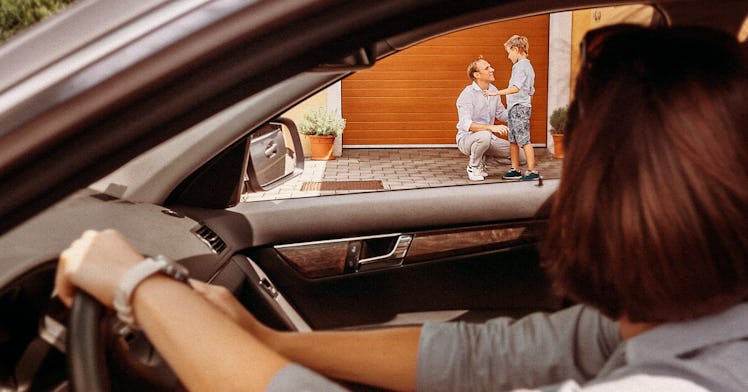Joint Custody Isn’t the Norm, But it’s More Likely Than it Used to Be
Mothers still get more nights with their kids, but courts now encourage shared parenting duties.

For most of the 20th century, dads who wanted to share custody of their children after a divorce were out of luck. Courts sided almost universally with the mothers, awarding them full custody. That’s not the case today. In the last 30 years, courts have increasingly encouraged — and even pushed — for mutual agreements of shared parental custody.
“The way that custody is evaluated by courts has changed over the decades, and the cases in which the mother had sole custody instead of the father… that has changed drastically,” says Kevin Kelly, an associate law professor at Seton Hall University’s Family Law Clinic.
There are two types of child custody. There’s legal custody, which is control over decisions around a child’s wellbeing, such as education, religion and health care, and there’s physical or residential custody, which is principally defined by where the child sleeps at night. Divorce laws vary by state, but generally, Kelly says, courts today start with a presumption of joint legal custody, and are open to and encouraging of shared residential custody. Equal splits of residential custody are uncommon for logistical reasons, since shuttling a child back and forth on school nights is hard for working parents, and, per Kelly, residential custody does still split in favor of the mother.
Still, there has been a marked shift since the 1980s in a father’s access to his children after, or in lieu of, marriage. According to a 2014 study by researchers at the University of Wisconsin-Madison found in a review of Wisconsin divorce records that mothers were granted sole custody 80 percent of the time in 1980; by 2008, that rate had dropped to 42 percent. Meanwhile, equally shared custody in which the children spent an equal number of nights with both parents increased from five to 27 percent, and unequal shared custody rose from three to 18 percent.
That 80 percent rate of sole custody granted to mothers in 1980 was likely even higher a decade before. Child custody for much of the 20th century defaulted to the mother: Courts preferred having a single party responsible for the children, and they reflected the prevailing attitude of the day that children — and especially young children — were better cared for by their mothers.
Per June Carbone, a professor at the University of Minnesota Law School who specializes in family law, changes in general notions about a father’s role in parenting, as well as laxer attitudes toward divorce, itself, led to increases in both the rate of divorce and the rates at which courts granted shared custody, beginning in the 1970s and accelerating in the 1980s
“This spike [in the divorce rate] followed the liberalization of the divorce laws, and they partly reflected the drop of the age in marriage and the increase in the number of brides pregnant at the altar that occurred in the ‘50s and ‘60s,” says Carbone.
Those pregnant brides were a result of the baby boom generation, which began getting married earlier — and regretting it, Carbone says. Meanwhile, states were realizing the untenability of at-fault divorce laws in which grievous wrongdoing had to be proven, and such restrictions were often coupled with a so-called ‘clean-hands doctrine’ in which the complaining party could not be found to have contributed to the marital strife.
Meanwhile, Carbone says, the Catholic church was losing its grip on politicians, who were becoming increasingly secular. As a result, in the 1960s and 1970s, states began to adopt no-fault divorce laws, making it sufficient for one party in a marriage to file for divorce because they were irreparably unhappy in that marriage. And since women initiate around two thirds of divorces, that, per Carbone, led to a lot of unhappy husbands wanting to secure time with their children.
“If what happens is the woman gets the kids in a divorce the man didn’t want, he feels utterly betrayed. And it’s those cases that were the push for a lot of the change in custody,” she says.
Other things were changing, too: During the same time, women joined the workforce at greater rates, childcare was becoming more widely available, and feminist ideologies were encouraging women to take advantage of each, and to include the divorced fathers of their children in child-rearing.
“As that happened, and divorce became normalized, the idea of joint custody became popular,” says Carbone.
Of course, divorced dads aren’t the only ones seeking shared custody of their kids: Half of American adults are unmarried, down from 72 percent in 1972, and 40 percent of childbirths in the U.S. today occur out of wedlock. Meanwhile, more than a quarter of children in the U.S. now live apart from their fathers. Those splits vary significantly across boundaries of race, educational levels, and economic status, and Kelly says such data suggests that fathers who were in a marriage, have greater income and assets and were involved in their kids’ lives are more likely to seek and obtain custody of their children.
Still, courts’ attitudes toward parental rights in custody cases involving parents who were never married are generally the same as they are in cases of divorce, he says, and unmarried dads with less economic clout fare much better today in seeking custody than in the past.
Perhaps the biggest sign of progress is that the majority of custody arrangements are resolved without a trial, as courts increasingly push parents toward pre-trial mediations, Kelly says. This results in more amicable agreements, smaller backlogs of cases in the family court systems, and fewer Kramer vs. Kramer courtroom fireworks.
“It’s changed over the years,” Kelly says. “Family law is very dynamic, it responds to things in society.”
This article was originally published on